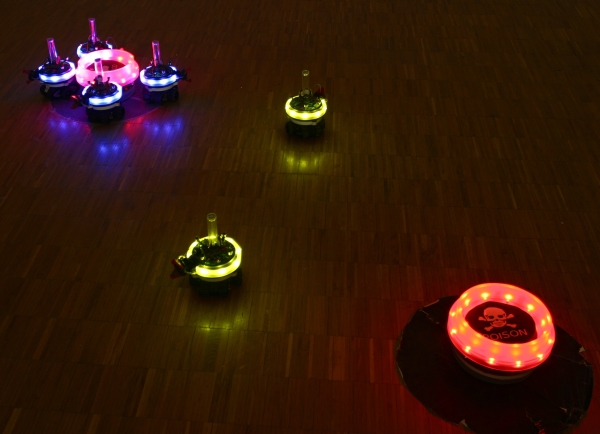The aim of this project is to address questions on the emergence and evolution of communication in groups of social organisms by using evolutionary robotics to build societies of autonomous robots that evolve a communication system to solve a particular survival task collectively.
Communication is an integral part of the social behaviour of all organisms, ranging from bacteria to humans. Despite extensive research to uncover its mysteries, its evolutionary dynamics remain elusive. Since communication does not fossilise, studying its evolution is an immensely challenging task. We propose that by applying experimental evolution with groups of robots, we can overcome some of the difficulties faced by empirical studies, as well as other modelling techniques, such as game-theoretical or mathematical modelling. The evolutionary approach allows us to access all the data about the evolving communication system and the corresponding behaviour in a relatively complex mechanistic model.
In previous and current work we have focused on the following issues:
-
Conditions for the emergence of communication
How does a communication system evolve and stabilise in a population? If the cost for signalling is high, why would an individual be interested in sharing information with the rest of the group? Our research has shown that different levels of genetic relatedness and levels of competition between/within groups highly influence the emerging communication system and its stabilisation.
-
The evolution of communication in competing populations
Communication between conspecifics can significantly enhance cooperative behaviour. However, such signals can also have detrimental effects because they can be exploited by other competing organisms. Here, we investigate the evolution and effectiveness of intragroup communication strategies and their robustness to intergroup competition.
-
The transition to symbolic communication
What are the differences between human and non-human communication? What is meant by symbolic communication? In what way is animal communication less symbolic than language? We aim to explore these questions through a number of experiments representing the transition from non-symbolic to symbolic communication.

This project is conducted in collaboration with Laurent Keller (UNIL).
Publications
Please note that the publication lists from Infoscience integrated into the EPFL website, lab or people pages are frozen following the launch of the new version of platform. The owners of these pages are invited to recreate their publication list from Infoscience. For any assistance, please consult the Infoscience help or contact support.